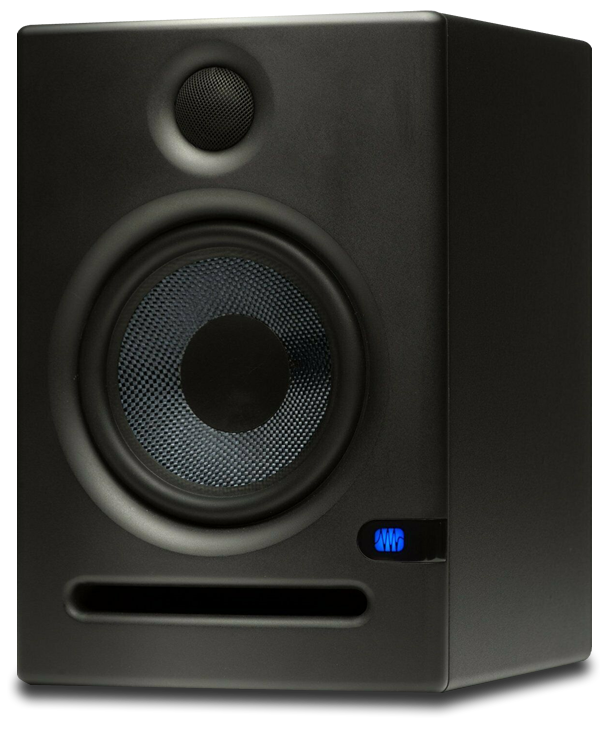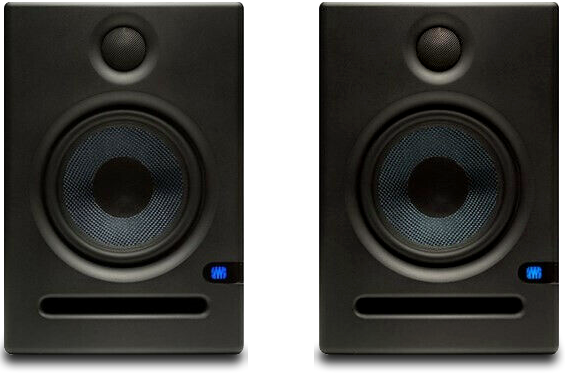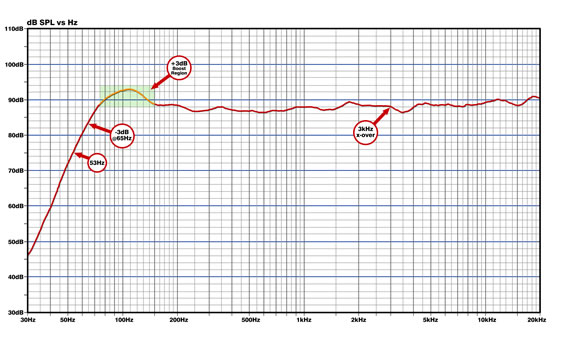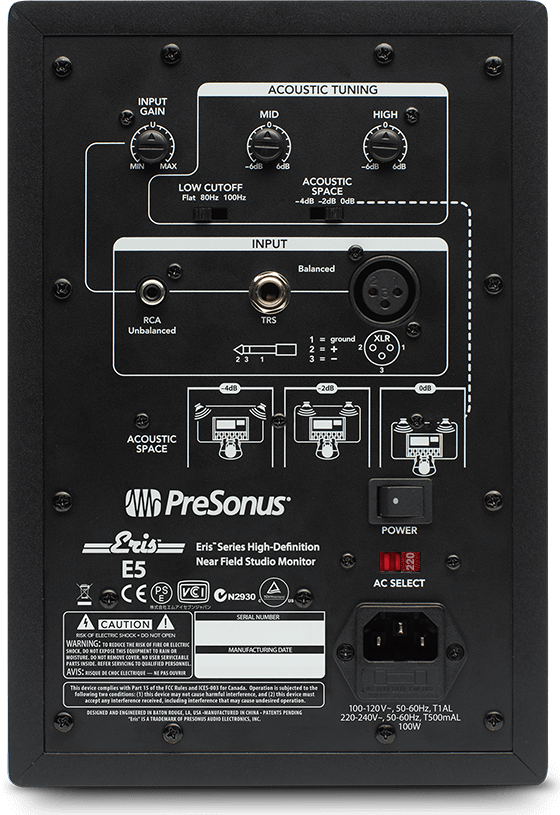Presonus Eris E5 - Powered Near-Field Studio Monitors


Eris E5 Monitors
Eris E5 Specifications
| Frequency Response | 53 Hz – 20 kHz |
| Peak SPL | 102 dB (@ 1M) (?) |
| LF Amplifier Power | 45W Class AB |
| LF Driver | 5.25” Woven Composite |
| HF Amplifier Power | 35W Class AB |
| HF Driver | 1” Silk Dome |
| Inputs (1 ea.) | Balanced XLR, Balanced ¼” TRS, Unbalanced RCA |
| Controls | Level, HF, MF, Low Cut, Acoustic Space |
| Dimensions (WxDxH) | 178 x 195 x 260 mm 7 x 7.7 x 10.2 inches |
| Weight | 4.6 kg (10.2lbs) |
For a manual and other documentation
please go to PreSonus ![]() .
.
Buying a Presonus Eris E5 Pair
Often the Eris E5 powered speakers become available as used single speakers. If the speaker for sale was once in a pair - you might want to pass it up. If the speakers were treated that badly that one blew up or was otherwise damaged, the remaining one may no longer perform to spec either.
Generally, the Eris E5 can be had for a very good price as new/retail. When I got my pair they were on sale (AUD $100 off list price). I thought at the time that there must be a newer model coming (as in clearance sale) - nope, they are still available new
years later. Just goes to show though, it pays to shop around.
While they feel like a sturdy little beast, the vinyl is very thin and easily damaged.
Just F.Y.I.:
I consider the cosmetic condition of items as an indicator of how well they have been cared for. So when I read something like 'excellent working condition, just normal cosmetic damage from use' and the picture looks like it came out of a war zone - well, that's one to pass up - there is a difference between abuse and normal use ;-)
Presonus Eris E5 Prices
Retail cost for the the Presonus Eris E5 powered speakers is in the realm of AUD $200 to $250 per speaker, with pairs often sold at a slight discount, like AUD $350.
Used ones, if you can find any, will probably go for at least AUD $250+ per pair if in good condition. Observation suggests that the majority of people who buy these speakers keep them.
I have only seen singles sold as used, which, as mentioned earlier, I consider suspect.
GEAR RELATED ARTICLES
[Home Music Recording Studio]
GUITAR AMPLIFIERS:
Acoustic 450 - 170W Guitar / Bass Amp Head
Behringer Ultrabass BXL1800A 180W Bass Amp
Fender Princeton Chorus 51W Compact Amp
GUITARS:
Aspen AD25 6 String Acoustic Guitar
Esteve Model 8 Classical Guitar
La Patrie Concert CW QIT Classical Guitar
La Patrie Presentation Classical Guitar
Fender DG-14SCE Nat Acoustic Guitar
Godin XtSA Electric Guitar
Godin Freeway Classic Electric Guitar
Ibanez RG8 8 String Electric Guitar
Jim Beam Devil's Cut 335 clone
Maton EM125C - 6 String Acoustic Guitar
Maton EM425C/12 12 String Acoustic Guitar
Maton Mastersound MS500 - 6 Str Electric Guitar
Yamaha FG-410-12A 12 String Acoustic
Yamaha G-228 6 String Classical
GUITAR FX - The Chronicles of Zoom:
ZOOM GFX-707 - Review and Description
ZOOM 707 II - Review and Description
ZOOM BFX-708 - Bass Guitar Multi Effects Pedal
ZOOM G9.2tt - Guitar Effects Console
Behringer EM600 Echo Machine Stomp Box
Behringer RV600 Reverb Machine Stomp Box
ROLAND U-220 - Vintage Sound / Synth Module
SN-U110 and SN-MV30-S1 Series PCM Cards
Behringer FBQ1502HD Ultragraph Pro
Behringer Eurorack Pro RX1602 Rackmount Mixer
Capabilities of the CASIO WK-7500 Workstation
Presonus Eris E5 Powered Monitor Speakers
Vonyx (Skytec) SPJ-1000A Active 10" Speaker
[ Advertising ]
Big value in a small package - Review Rating 8 / 10
 About Review and Description articles - click to expand ...
About Review and Description articles - click to expand ...
When you use new equipment that quickly becomes transparent, that is, you don't even notice that it's there ... that's when you know you've made a good choice.
This particularly applies to critical elements in the recording chain, like monitor speakers. If their sound is 'coloured', stands out or just seems to need constant attention and/or adjustment ... you really need to be using some 'other' monitors.
The Presonus Eris E5 Near-Field Studio Monitors are a neat, unassuming and compact package that will really (and pleasantly) surprise you. They actually deliver exactly what they are supposed to, a crisp and well balanced listening experience. Not to suggest that they are perfect, rather that they are exceptionally good value given their modest price.
I've been using the Eris E5 speakers for around
![]() years now, and I'm very pleased with them. Released in 2013, as of 2023 they are still readily available. Of course there are also newer designs that may be worth investigating.
years now, and I'm very pleased with them. Released in 2013, as of 2023 they are still readily available. Of course there are also newer designs that may be worth investigating.
For a manual and other documentation please go to PreSonus ![]() . They even have a tutorial PDF available. There is also a Presonus monitor calibration video on YouTube
. They even have a tutorial PDF available. There is also a Presonus monitor calibration video on YouTube ![]() .
.
 Using Studio Monitor Speakers and Other Output Options:
Using Studio Monitor Speakers and Other Output Options:
Since before time began, when there was only the void ... ok, not really quite that long ago ... There has been a debate (and/or heated argument) about whether Monitor Speakers were better than Headphones. This somewhat silly stouche often missed the real issue.
It's not a question of which or what is better. It is really a question of "how does your intended audience listen to their music?" These days that will often be neither headphones nor speakers, but rather ear-buds.
While ear-buds are compact and convenient they also appear to be damaging a lot of ear drums due to excessively high listening levels - mostly likely caused by people trying to block out background sounds (e.g. while traveling).
Now, if someone thinks that mixing down for that ear-bud kind of audio experience will create a well-balanced mix and/or sound ... they have my best wishes and sympathy (ok, I'm lying about the sympathy ;-)
The simple truth is, you need monitor speakers and good headphones. You also need to test your mix through ear-plugs, boom-boxes, PC sound cards, Flac, MP3 and any other delivery medium you have available ... in stereo and even Surround Sound ... because, whatever you create, it will probably be played on/through all of them (... of course, that assumes it gets played at all ;-)
Moving on ...

What's in the Box?
The Presonus Eris E5 is a solid 4.63 kg (10.2 lbs) per speaker enclosure. The front-firing, bass-reflex acoustic port design provides excellent low-frequency reproduction for its size.
The
low-frequency transducer is a 5.25 inch (133 mm) long throw Kevlar™ K100, the high-frequency transducer is a 1 inch (25 mm), ultra-low-mass, silk-dome tweeter.
The system is powered by 80 watt, Class AB bi-amplification to generate a healthy (claimed) maximum SPL of 102 dB continuous.
(SPL = Sound Pressure Level, usually measured as dB at 1W at 1 Metre)
While this is a very respectable output performance, it is at odds with the information posted in their own spec sheet - see below.
Aside from a very simple, and rather small (A5) printed instruction manual, there is only the power cable, which is a reasonable 1.5 metres in length. A 2m power cable would have been better. Fortunately it uses a DIN power connector, so any longer PC or monitor power cables you have can be easily substituted.
Sound Quality / Frequency Response (7/10)
Objective:
Frequency Response is stated at a reasonable 53Hz to 22KHz with a 3KHz crossover. The bottom end roll-off doesn't meaningfully start until you get down to 75Hz, which is majorly impressive for such a small speaker.
There is a bit of a bump in the frequency curve between 75Hz and 150Hz (almost 6dB) which may be creating an auditory illusion of greater bass response. This could be largely negated by the Low Cut switch, which has Flat, 80Hz and 100Hz options.
For really solid low frequency bass sounds, the addition of a subwoofer will help round out that last bit of the bottom end below 100Hz. This will of course be much more significant when recording, say Techno, than while recording an acoustic instrument mix.
Presonus do provide an Eris E5 specification sheet from their downloads page, which includes a Sound Pressure Level vs Frequency Response graph. I have redrawn and annotated this graph below.
You might notice a few interesting things on this graph, such as:
- The graph is largely meaningless because no actual reference input or output levels are defined. So there is no way to know what the claimed values relate to.
- At no point does the graph even come close to an SPL of 102dB (the claimed Peak SPL). Based on the graph, a generous average SPL would be in the realm of 90dB, while the maximum SPL displayed in the graph, is 93dB.
- The claimed frequency response is 53Hz to 22kHz.
At 53Hz the SPL is shown as 75dB, which is 25dB down from the generous average mentioned above. So calling 53Hz the low end of the response curve is also another manufacturer's exaggeration (at least from my perspective).
It always amuses me to see the marketing hype contradicted by the provided 'technical information', even when it is only psuedo-technical.

Subjective Listening (or ... but how do they "really" sound?)
Well - Very nice actually. Due to my age, I can't verify performance above 15kHz, but I'm still good below that - and I have been well pleased by these speakers since I got them in 2014. They are well balanced and without any annoying bad habits.
The available controls, including the "Acoustic Space" switch allows for simple adjustments if required. Though I generally prefer a flat (or near as) output if possible.
This is where I would recommend you find other reviews by people who make similar music to your own, to find out what they think. While I like a good, tight bottom end (I'm sure there is an unutterable, politically incorrect and totally sexist joke lurking there), I don't make music that can deform car doors ...
![]()
Output Power
The Presonus Eris E5 has a very well balanced 80 Watts RMS output. And even if the claim for 102dB(?) per watt, per metre is a tad exaggerated, these speakers can still hurt your ear drums if you crank'em up.
In practical terms that means there is
plenty of headroom available even if you need to do an occasional loud demo. I have wound the E5s up to see what they can do, and they are clean all the way to maximum output.
This solid and clean output is provided via bi-amped Class AB power amplification. With a split of 45W for low frequency and 35W for high frequency, crossed over at 3KHz.
Whilst Presonus brag (a lot) about pretty much everything relating to these powered speakers, there is no mention of THD, IMD or any other form of distortion. Makes me suspicious ;-)
[THD - Total Harmonic Distortion, IMD - Intermodulation Distortion]
And lastly - worth noting here - you can get a little more bottom end and power output from the slightly larger/louder Presonus Eris E8 with the 8" LF driver. I tried to order a pair of the E8s (for my rig), but sadly my local music shop is no longer associated with Presonus and I had to settle for a pair of the somewhat more expensive Yamaha HS8 speakers instead - sad perhaps, but (as you may have guessed) I'm not crying. When I find the time, there is sure to be a review of the HS8's at some point ;-)
Flexibility (8/10)
The Eris E5 is a Near-Field Monitor. In a studio, they ideally want to be no more than about 1 metre from your ears. Very useful when you don't have much studio space to work with. They will comfortably fit on a large desk, but you may have to raise them to ear level. I currently have them either side of a 50" 4K monitor - works a treat!
Presonus have provided an "Acoustic Space" switch to accommodate the three most common / likely speaker layouts. I have not found it to be of much use and leave it set to flat.
And even if you have plenty of space, an Eris E5 set would make a good "B" speaker, for sound checking.
As mentioned, the Eris E5 can deliver a healthy 80 Watts RMS each. I have used them to set up my guitar effects (for FR/FR) and for a little (not at all quiet) rehearsing. They performed admirably. An E5 pair can't fill a large room with booming bass, but at close quarters they really are a potent little package.
With a subwoofer an Eris E5 pair could be used as a micro PA in a café scenario, or very high class foldback in tight spaces. For example, Keyboard players might find these particularly useful.
[FR/FR - Full Range / Flat Response. Necessary for high-end modellers / Profilers like Fractal Audio AXE-FX, Kemper, Line-6 Helix, etc.]

Rear Panel Details
Ideally, a set of monitor speakers should be 'Set and Forget', and that has been my experience with the Eris E5 monitors. Unless you move things around, you should not need to make further adjustments.
The rear panel is populated by a level control, Mid and High EQ, which at ±6dB each are intended for subtle tweaking only.
The Lo Cutoff switch (Flat, 80Hz and 100Hz) may be useful if there are walls close behind your speaker setup and you need to lose some bass.
The Acoustic Space switch (-4dB, -2dB and 0dB) can be used to select 'adjustment levels' for three common speaker and desk configurations.
A comprehensive set of inputs comprise of an unbalanced RCA, 1/4" balanced TRS and of course
a balanced XLR.
A Power Switch, Voltage Selector (leave alone once set), and DIN power socket with fuse complete the list of rear panel items. There are diagrams and adequately clear labels for all items. Click on the picture at right for a larger rear panel image in a separate tab.
Build Quality (8/10)
The black vinyl covering is thinner than paper and can be easily damaged. Probably best not left in direct sunshine.The black vinyl is also rather slippery. Combined with the rounded corners, that makes it very easy to drop these speakers - which I have, while adjusting position. My Eris E5s are currently situated on non-slip rubber pads.
The box itself is typical MDF construction with a contoured plastic front to aid sound dispersion, reduce standing waves and avoid frequency spikes. Overall, well presented, does a job.
The rear panel is clearly labeled and uses quality components
- there is nothing cheap and nasty about these speakers.
Value For Money (9/10)
I really like the Eris E5 monitor speakers. I like the simplicity, the sound, the lack of tweaking and the price. You can pay considerably more and still not have anything meaningfully better. I recommend them - big tick!
If you have used these monitors and changed or upgraded, feel free to leave a note below with your thoughts. If you'd like a reply please include your email within the note (email addresses are not posted).
Review Ratings:
- Flexibility - 8 / 10
- Sound Quality / Frequency Response - 7 / 10
(Frequency Response not as good as claimed) - Build Quality - 8 / 10 (Vinyl covering sucks)
- Durability & Reliability - 8 / 10 (Never had a problem, but they take cosmetic damage easily)
- Value for Money - 9 /10
- Overall Average Score ... 8 / 10
Your comments and contributions are greatly appreciated!
Was this page useful?
Rate This Page:
| Page Ratings so far ... | ||
| Excellent | 19 | |
| Very Good | 1 | |
| Useful | 1 | |
| Not Useful | 0 | |
| TOTAL | 21 | |
Page online for years
Your Comments:
230313 - (Excellent) - Great, no nonsense review - thanks!
201030 - (Excellent) - Wow, I was searching for such an article... thank you for that! :)
200930 - (Excellent) - Based on the graph, it seems easy to get a relatively flat response: roll the bass back -4 db and the treble back -2 db. Some guy on Youtube set his up that way for a living room demo and they sounded right with those settings. Bass was very clear but not boomy or hollow sounding, and there was just enough sparkle to make it sound live. I'm going to try to pick some up before they run out.
Editor's Note: As mentioned above, I like the Eris E5 speakers a lot and highly recommend them for near-field monitoring.
Regardless of a speaker's (supposed) specs though, a truly flat output for a given location will only be achieved with a tone generator and a reference mic. So in the end, for most of us, it really comes down to getting the sound that we like and the hope that it's within the specification range we need or want
... and ... I hope that you are well pleased with your purchase.
As for YouTube ... 20% totally awesome, 50% mediocre and/or questionable and 30% total bullshit. I may have over-rated the totally awesome and under-rated the bullshit.
Incept Date: Wizard - 150901 (191005)
Last Update: Wizard - 231012
